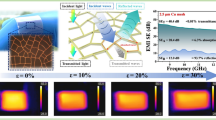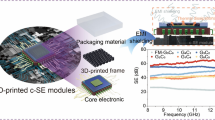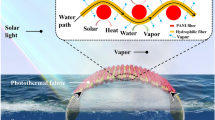In order to solve the problem of wiring breakage in the conductive layer caused by a fold in the bending area of a flexible organic light-emitting diode (FOLED) and improve the conductive layer in the bending area of a FOLED, the conductive layer wiring scheme in its bending area is optimized. First, the polymer substrate FOLED samples are prepared, and the bending area structure is formed by stacking the resin, pin, metal wires and other layers. An equivalent working condition of the bending process is analyzed, and the three-dimensional finite element modeling of the bending area of the FOLED is completed. According to the simulation analysis results of the FOLED bending area, it is proposed that the optimal design of Resin ply thickness is as follows: the limiting conditions of material damage in the conductive layer should be fully considered, and the material damage mechanism should be studied to ensure that the cumulative plastic strain of A-A and B-B positions is smaller while being free from damage; the optimal wiring scheme design for the conductive layer is the following: using the square of optimal stress distribution to reduce the fracture angle, the routing scheme of crossing route type > full filling type > internal opening type should be adopted.
Similar content being viewed by others
References
L. Huan, J. L. Xin, and B. C. Xing, IEEE. Trans. Electron. Devices., 48, 1 (2018).
A. A. Zhamaletdinov, E. P. Velikhov, and A. N. Shevtsov, Dokl. Earth. Sci., 474, 641 (2017).
T. Kim, K. H. Lee, and J. Y. Lee, J. Mater ChemC., 72, 88 (2018).
W. Peng, J. Zhang, and D. Lei, Chem. Mater., 29, 112 (2017).
L. L. Ma, L. Yang, and H. C. Zong, Chemelectrochem, 4, 1443 (2017).
R. R. Cao, S. Liu, and Q. Liu, IEEE. Electron. Dev. Lett., 38, 1371 (2018).
M. Gruber, A. Müller, and V. Jovanov, IEEE J Photovoltaics, 39, 1 (2017).
H. Y. Liu, G. J. Liu, and R. C. Huang, IEEE. Sensors. J., 17, No.16, 5087 (2017).
X. Jin, A. D. Sendek, and E. D. Cubuk, Acs. Nano., 11, 19 (2017).
R. Yan, X. J. Ma, and Y. Z. Liang., J. China Acad Electron Inform Technol., 12, 7 (2017).
L. Pan, H. C. Wang, and M. Y. Chu, J. Pow. Supply., 17, 140 (2019).
K. Xia, X. L. Fu, and Z. R. Li, Chin. J. Pow. Source., 43, 116 (2019).
J. J. Qu, Autom. Instrum., 15, 226 (2017).
R. N. Sa, J. Jilin Univ. (Sci)., 55, 180 (2017).
Y. Y. Li, K. F. Liang, and Z. Y. Yuan, Comput. Simul., 34, 55-62 (2017).
T. S. Brown, S. Du, H. Eruslu, and F. Sayas, Appl. Math. Nonlinear Sci., 3, 55 (2018).
C. R. Fernández-Pousa, Appl. Math. Nonlinear Sci., 3, 23 (2018).
Z. Xiong, et al., Multimed Tools Appl., 78, No.22, 31035 (2019).
F. Khellat, and M. B. Khormizi, Appl. Math. Nonlinear Sci., 3, 15 (2018).
G. Lakshminarayana, K. Vajravelu, G. Sucharitha, and S. Sreenadh, Appl. Math. Nonlinear Sci., 3, 41 (2018).
H. C. Bozduman, and E. Afacan, Appl. Math. Nonlinear Sci., 5, (1), 479 (2020).
N. Gao, H. Hou, J. H. and Wu, Int. J. Mod. Phys. B, 32, No. 20, (2018).
N. Gao, H. Hou, Y. Zhang, et al., Mod. Phys. Lett. B, 32, No. 4 (2018).
J. P. Ruiz-Fernandez, J. Benlloch, M. A. Lopez, et al., Appl. Math. Nonlinear Sci., 4, No. 1, 21 (2019).
Author information
Authors and Affiliations
Corresponding author
Additional information
Translated from Izvestiya Vysshikh Uchebnykh Zavedenii, Fizika, No. 3, pp. 74–84, March, 2021.
Rights and permissions
About this article
Cite this article
Ma, L., Gu, J. Optimized Design of Wiring Scheme for Conductive Layer in Bending Area of a Flexible OLED. Russ Phys J 64, 450–462 (2021). https://doi.org/10.1007/s11182-021-02349-8
Received:
Published:
Issue Date:
DOI: https://doi.org/10.1007/s11182-021-02349-8




